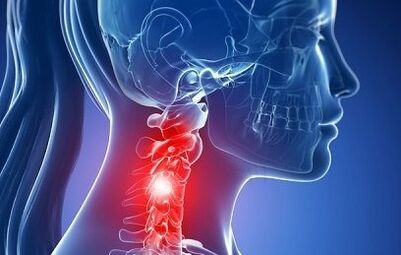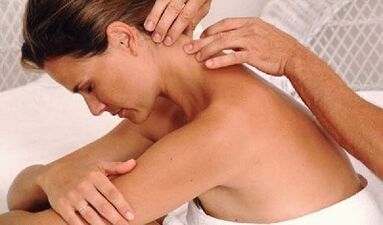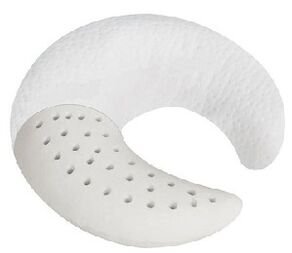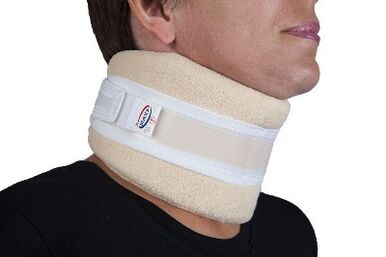
Osteochondrosis is a lesion of the intervertebral discs with degenerative dystrophic nature, and the cervical region is the most vulnerable part of the spine that has an anatomically different structure of very close to another vertebra and weak muscular corset.Therefore, even with small additional loads of the neck, vertebrae can appear, leading to the drainage of blood vessels and nerves.
And since the spinal arteries involved in the blood supply to the brain pass through the holes in the transverse processes of the vertebrae in this department, the impressions of the vertebrae in this department or the squeezing of the holes with overgrown osteophytes are filled with very severe consequences.
What is it?
Osteochondrosis of the cervical region is a polyethiologically progressive disease that is manifested by degeneration of the intervertebral discs and the dystrophy of the ligamental apparatus of the spine.
Reasons
The main causes and prerequisites for the onset of cervical vertebra osteochondrosis are:
- Returning the spine, scoliosis.
- Stress, nerve loads adversely affect the general condition of the body, can cause cervical osteochondrosis.
- Transferred infectious diseases often become the root cause.
- The wrong, uncomfortable position of the body during sleep (such as an uncomfortable pillow).
- Congenital problems or the presence of hereditary diseases of the cervical spine.
- Disruption of the posture in young and adolescents.
- Excess weight, obesity of different degrees.Suspended pounds increase the load on the vertebrae and disks, leading to degenerative processes.
- Back injuries that may have happened in childhood or adolescence.
- Disruption of metabolic processes.
- A work related to physical labor that can provoke diseases of the spine in different departments.
- A cheap lifestyle, sitting work, improper performance of any exercise.
For the successful treatment of osteochondrosis of the cervical region, it is first necessary to determine the cause of the occurrence, the prerequisites that caused its development and eliminate them.Until recently, the disease was found only in people 45 years of age.Now young people are subjected to it, the age range is 18-25 years old.
Characteristics of the cervical region
Consider how the cervical region is different from the rest of the spine and that in the process of the development of osteochondrosis, it serves as a prerequisite for the development of these syndromes.
- There are important ganglia (nodes) of the autonomic nervous system in the cervix.
- There are holes in the transverse processes of the vertebrae that form a canal through which the spinal artery passes, which supplies oxygen and nutrients the brain, brain, auditory organs, and the spinal nerve.These are the prerequisites for frequent artery and nerve brackets.
- The spine is the most movable.It is characterized by all types of movements in full.These are prerequisites for frequent violations and subluxations.
- The intervertebral holes of the lower three vertebrae are not round but a triangular shape.These are prerequisites for disruption of nerve roots with bone growths, which are formed with osteochondrosis.
- The intervertebral discs are located between the bodies of the vertebrae that are not everywhere.In front of them are protruding edges of the vertebrae that are interconnected with joints.These are the prerequisites for the appearance of subluxation of the joints.
Stages of development
The degree of osteochondrosis is determined by the clinical picture and the patient's complaints.The concept of the degree should not be confused with the stages of osteochondrosis.The stages will be discussed below.
- The first degree.The clinical manifestations are minimal, the patient may complain of low -intensity cervical spinal cervical spine, it can be increased when the head rotates.During a physical examination, a slight tension of the neck muscles can be detected.
- The second degree.The patient is concerned about the pain in the cervical spine, his intensity is much greater, there may be radiation in the shoulder, in the arm.This occurs due to a decrease in the height of the intervertebral disc and disturbed on the roots of the nerves.The pain intensifies when it tilts and rotates the head.The patient may note a decrease in efficiency, weakness, headache.
- The third degree.The symptoms of cervical osteochondrosis are exacerbated, the pain becomes constant with radiation in the arm or shoulder.Tingling or weakness occurs in the muscles of the arm as the hernia is formed on the intervertebral discs.Concerned for weakness, dizziness.The study reveals the restriction of mobility in the cervical spine, pain in palpation of the cervical spine.
- Fourth degree.There is complete destruction of the intervertebral disc and its replacement with connective tissue.Dizziness is increased, tinnitus, coordination impaired, since the spinal artery is included in the vertebra process, which feeds the brain and the back of the brain.
Symptoms
The severity of the symptoms of cervical osteochondrosis depends on the degree of destruction of the vertebrae structures.Symptoms worsen with bone tissue growth with osteophyte formation, radicular syndrome (root pain when squeezing the nerve), intervertebral hernia (convexity of the disc in the spinal canal).
The first signs of the disease are a periodic headache in the neck, neck soreness, crunching and clicking in the vertebrae when the head is rotated, sometimes slight tingling shoulders.Over time, the symptoms grow and the intensity of pain increases.
Pain syndrome is the main manifestation of osteochondrosis.Neck pain is a stupid constant or acute with the bastards under the back of the back of the head as it turns the head.The entire cervical compartment or projection zone can harm a modified vertebra, as well as collar, shoulder, spatula, area of the heart.The irradiation of pain in the lower jaw, teeth, arm, ear, eye area is not excluded.The muscles of the neck and shoulders are tense, painful on palpation.It is difficult to lift the hand from the side of the lesion - there is immediately a shot in the shoulder or neck.Restricting head movements due to pain often occurs in the morning after sleep in an uncomfortable position.
The disease leads to the pressure of the roots of the peripheral nerves (Roying syndrome) and causes pain on these nerves.It is possible to tingle the hands or fingers, a violation of the sensitivity of certain skin areas innervated by a pressed nerve.
For some characteristic symptoms, we can assume which vertebrae are affected:
- C1 - damaged sensitivity in the back area;
- C2 - pain in the dorsal and parietal regions;
- C3-A reduction of sensitivity and pain in half of the neck, where the spinal nerve is impaired, impaired sensitivity of the tongue, disturbance of speech due to loss of control of the tongue;
- C4 - impaired sensitivity and pain in the shoulder area, reducing the tone of the muscles of the head and neck, respiratory disorders, pain in the liver and heart are possible;
- C5 - pain and impaired sensitivity in the outer surface of the shoulder;
- C6 - pain spread from the neck to the shoulder blade, the forearm, the outer surface of the shoulder, the radial surface of the forearm to the thumb;
- C7 - pain spread from the neck to shoulder, the back surface of the shoulder, the forearm to the fingers II - IV of the arm, impaired sensitivity in this area.
- C8 - pain and impaired sensitivity, spread from neck to shoulder, forearm to the little finger.
Cervical osteochondrosis is always accompanied by a headache.Severe, constant pain is increased by rotation of the neck or sudden movements.Some patients complain about the weight in their head.The compression of the spinal artery leads to attacks of dizziness, nausea.There is noise in the ears, ringing, flickering black spots in front of the eyes.The worsening of cerebral circulation causes a progressive decrease in hearing and vision, tingling of the tongue, a change in taste sensations.
Clicks or neck cribs almost always accompany the cervical osteochondrosis observed in each patient.A crunch appears during a sharp turn of the head or back of the back.
Syndromes caused by cervical osteochondrosis
Symptoms of cervical osteochondrosis are formed in certain groups called syndromes.Their presence and weight can indicate pathology in the cervical spine with updated localization.
A group of common syndromes:
- Vegetative-diabolic syndrome.Sulux the first vertebra of the cervical departure with displacement can lead to the development of vegeta-vascular dystonia.This is not a definite diagnosis of VVD as there are no symptoms pronounced.There may be neurological signs, symptoms of impaired brain blood flow, intracranial pressure, muscle cramps.As a result, the patient's complaints are reduced to dizziness, reduction of visual acuity, loss of consciousness, headache, nausea.
- Irritable reflex.Burning and acute pain in the back of the head and neck, sometimes with the return to the chest and shoulder, which occurs at the time of change in the position of the head and neck, when sneezing and a sharp turn on the head.
- Korean.Otherwise, called cervical radiculitis, it combines the symptoms associated with impaired nerve roots of the cervical vertebrae."Goosebumps" in the affected area, numbness of the fingers, forearms, pasteliness of the skin, spreads in certain fingers, are characteristic.
- Heart.Almost the same picture with angina often leads to improper diagnosis and treatment.The syndrome occurs due to irritation of the diaphragmatic nerve receptors, partially captivating the pericardium and a large pectoral muscle.Thus, the spasms in the heart area are more reflex, such as an examination of irritation of the cervical nerves.
- Vail Arttery Syndrome.It develops directly both with compression of the artery itself and by irritation of the sympathetic nerve plexus located around it.The pain in this pathology burns or throbs in the back with whiskey, lessons, crows.It arises from both sides.Patients usually associate the aggravation with a post -sleep condition in the neooseleological posture, travel in transport, walking.With pronounced symptoms, hearing loss, dizziness, tinnitus, nausea, vomiting, loss of consciousness and increase in blood pressure.
Diagnostics
Like any diagnosis in medicine, the diagnosis of osteochondrosis is found on the basis of patient complaints, a history of the disease, clinical examination and methods of ancillary tests.X -ray cervical spine in direct and lateral projections, if necessary in special positions (with mouth open).At the same time, experts are interested in the height of the intervertebral discs, the presence of osteophytes.
Modern research methods use IAMR and CT tests that do the diagnosis as accurately as possible.In addition to the following methods of additional research, consultations of related specialists (cardiologist, ophthalmologist, neurosurgeon) may be required, and the neurologist's examination is simply vital.The neurologist is involved in the treatment of osteochondrosis, so after examining the patient, he will prescribe the necessary minimum examination at his discretion.
How to treat osteochondrosis of the cervical spine?
The complex treatment of cervical osteochondrosis may include the following traditional and non -traditional methods: drug treatment, massage, acupressure, manual therapy, physiotherapy, acupuncture, homeopathy, folk remedies and more.
The main treatment regimen for osteochondrosis is the same for all locations of this disease:
- You must first remove the pain syndrome.
- Then the edema will be removed.
- At this stage, it is necessary to normalize blood circulation.
- Strengthening the muscle corset.
- Improving nutrition and tissue regeneration.
The list of medicines and medicines for the treatment of cervical osteochondrosis at home is very extensive:
- Anti -inflammatory (steroids).These are hormonal drugs that relieve inflammatory phenomena and thus eliminate pain;
- Analgesics (non -steroidal drugs that relieve pain).They are usually prescribed in the form of tablets or capsules.It should be remembered that most of these drugs cause irritation of the mucous membrane of the digestive tract;
- Mussorelaxes are medicines that relax muscle tone.They are used in surgery and orthopedics as ancillary drugs to stop pain.Such medicines are administered parenterally and therefore always under the supervision of a doctor.There is an extensive list of contraindications;
- Chondroprotectors are medicines containing substances that replace cartilage components.In order to achieve a constant positive effect, such drugs must be taken for a very long time;
- Ointments and gels for outdoor use.This is the most affordable group of medicines in the home atmosphere.They are divided into relieving inflammation, warming and painkillers.Such funds are often advertised.With cervical osteochondrosis, not all ointments are effective, in addition, due to accessibility, they are sometimes unjustifiably used and without taking into account the characteristics of pathogenesis.
- Vitamins.Osteochondrosis prescribes vitamins, which have a beneficial effect on the peripheral nervous system and improve conductivity.Water -soluble vitamins: B1, B6, B12, vitamins, soluble fats: A, C, E, E. In recent years, medicines containing both painkillers and vitamins components have been combined.

Only the team of good specialists, including a neurologist, physiotherapist, massage therapist, surgeon, preterior, can choose the most appropriate therapy.
Medical physical education
LFK for cervical osteochondrosis should be performed out of acute exacerbation.The biggest efficiency of this technique during the recovery period.There should be no discomfort and pain during the application of the complex!
- Exercise number 1. Lies on your stomach, rest your hands on the floor, lift your head and torso, your back should be right.Stay in this position for 1-2 minutes.Slowly sinks to the floor.Repeat 2-3 times.
- Exercise number 2. Lies on your stomach, stretch your hands on your body, turn your head to the left, try to touch the floor with your ear, then turn your head to the right.Repeat 6-7 times in each direction.
- Exercise number 3. In a sitting position, bend forward and try to touch your chest with your head, then exhale, lean back and throw your head.Repeat 10-15 times.
- Exercise number 4. When sitting, put your palms on your forehead, put pressure on your palms on your forehead and your forehead is on your palm.Continue this exercise for 30 seconds.Repeat 2-3 times.
- Exercise number 5. Slowly turn your head first in one direction, then in the other direction.10 rotations in each direction.Make sure there is no dizziness.When it appears, the exercise stops.
Therapeutic massage
Massage can be performed at home, but very carefully so as not to cause exacerbation and not harm the patient.The patient should take the position to lie down, put his forehead on his hands and stretch his chin to the chest.In this case, the neck muscles should be completely relaxed.
- Gali.You need to start a massage with these movements: suppress the collar area in the direction of the lymph to the exceeding and axillary nodes.Then flat and cracking are used.
- Pressure.In order to drain, the massage therapist puts the hand through the neck (the index and thumb must be together) and move down the spine.Squeezing can also be done from the edge of the palm to the joints of the shoulder.
- TRIPERATION.Kalfins are performed to warm the muscles, relax them and improve blood flow to this area.Massage should start from the base of the skull, performing with round movements of the fingers and direct movements.You can also move saws by placing your palm parallel to the ribs.
- Kneading.The neck should be mixed in circular motions.
- Vibration.The massage is completed by gas and vibrations, which is done with the help of shocks and shocks.

Massage is necessary to strengthen muscle tone and relieve pain.Depending on what stage osteochondrosis is, the technique of massage is chosen.Nevertheless, when they do neck massage, experts use all the techniques of classic massage: rubbing, gales, mixing and more.In cases where the patient hurts only on one side, the massage begins in the healthy part of the neck, gradually moving in that part of the collar area where pain occurs.
Manual therapy
Manual therapy helps to cope with both acute and chronic pain, also increases the volume of movements and improves posture well.The basic techniques of manual therapy for osteochondrosis of the cervical spine:
- Relaxing and segmental massage.It is used to heat the muscles and relieve tension.
- Mobilization.Impacts aimed at restoring joint functions by grip.
- Manipulation.Acute impetus aimed at the patient's pathological areas.The procedure is accompanied by a characteristic crisis (return of the joint to a normal position).
A specialist practicing manual therapy should have these techniques perfectly.Otherwise, any error can lead to injuries.

Orthopedic pillows
Orthopedic sleep pillows are an effective prevention tool.In many cases, osteochondrosis worsens due to additional transmission of the cervical artery and nerve roots during sleep on an uncomfortable pillow.The orthopedic product provides a uniform horizontal position of a person during sleep and thus guarantees physiologically complete blood supply to the brain.
When choosing a pillow, the individual anatomical characteristics of a person must be taken into account and they must be related to the volume and characteristics of the filler.Properly selected pillow brings tangible benefits to the patient with osteochondrosis of the cervical spine.
Physiotherapy
Physiotherapy procedures for osteochondrosis of the cervical region:
- Electrophoresis.It should be used with the help of painkillers (anesthetics), which are introduced under the skin by electronic impulses.
- Ultrasound.It favorably affects the metabolic processes in the tissues of the cervical region, which is why the swelling is eliminated, the pain leaves.
- Magnetotherapy.Safe treatment technique that consists in the effect of damaged cells on a low -frequency magnetic field.This gives an analgesic effect, acts as an anti -inflammatory agent.
- Laser therapy.Improves blood circulation in the area of damage, relieves tissue swelling, pain.
Physiotherapy procedures have a beneficial effect on the discs and vertebrae with cervical osteochondrosis.In combination with medicines, combination treatment helps to get rid of the symptoms of the disease.The procedures are performed in a hospital or specialized offices in clinics.Before starting the course, it is necessary to consult a doctor, to determine the duration of physiotherapy, types.It is strictly forbidden to pass it during exacerbation.

Chane collar
Shantsa collar is a soft and comfortable device, fastening behind velcro and used for cervical osteochondrosis.But not for treatment, but for temporary relaxation and elimination of fatigue.It cannot be worn without removing, otherwise the neck muscles will stop working soon atrophy.If the Chantza collar is selected properly, the patient feels comfortable and secure.
The collar is strictly selected in a pharmacy or orthopedic store.Better in the store because the people who work there generally know their business and the characteristic of the goods and can therefore help in a case -by -case basis.
Folk remedies
If the pain of osteochondrosis of the spine becomes unbearable and regular, then you will agree with everything if only to stop it, and here the traditional complex treatment will successfully complement folk methods.
- Insist the celery root (5 g per 1 liter of boiling water) for 4 hours, drink a tablespoon before each meal;
- Copper compress, for which we take 2 tsp.honey and 1 tablet mummy.We heat the components in a water bath, spread over the fabric and apply to the cervical area, that is, the neck at night;
- In acute pain, the hell that grows in the country helps me.Its leaf is just mine, I dial me with boiling water, cool it a little, put it on my neck and hide it with a thin scarf at night - in the morning you can already live and work;
- We insist on chamomile flowers in vegetable oil for two days, after heating until boiling (30 ml of oil is required for 30 grams of plant), rub in inflamed areas;
- The compression of the honey frame also helps to do so, the root harvest should be rubbed and mixed with honey in the same amount, attached to the inflamed neck at night, use it regularly, at least once a week.
Prevention
As usual, proper prevention will help to avoid osteochondrosis of the cervical region, but of course, all exercise should be used regularly, otherwise there will be not many benefits of "periodic" classes.
It remains to remember simple rules:
- Eat more products with a large amount of calcium and magnesium.These are fish, peas, legumes, nuts, cheese, greenery, but from sugar, flour, smoked, sharp is better to refrain.
- It regularly exercises, especially swimming, aquaerobics, also to prevent osteochondrosis, gymnastics for stretching and vertebrae flexibility is appropriate, which can be practiced at home.
- When sitting at least a few times a day, perform a special set of exercises.
- Choose a good orthopedic mattress and pillow, ideal for the neck that supports the head in the right anatomical position (yes, your favorite huge pillows with spine problems will not pass!).
If you already have such a diagnosis, then the patient should spare his spine, namely:
- To be very careful with lifting and wearing weights, it is better to go to the store twice than to pull intolerable bags in both hands, incredibly straining the stream of the neck and shoulders;
- Do not spend, avoid towing and cold air from the air conditioner (some like to cool on a hot day, turning into the back to the fan);
- When you tilt the body forward - do not forget osteochondrosis;
- Avoid local muscle overheating, which can happen among lovers of too hot bath;
- Remember to break off the monitor periodically, change the position of the body, do not sit for hours or even days;
- Give a door rest that needs to buy a chantsis collar;
- If possible, if the condition of the cardiovascular system allows, suffocated in the bath.
In conclusion, I would like to say that the child who threatens osteochondrosis (father and mother already have it) and an adult who has acquired the disease in the process of life, just has to take preventative measures so that it is not disabled and not to be on the operating table, since this operation is quite complicated and requires long -term rehabilitation.In addition, it is not always possible as there are non -surgical cases, so it is better to protect health with younger juniors while the discs are intact and unnecessary growths do not wipe out the blood vessels.


















